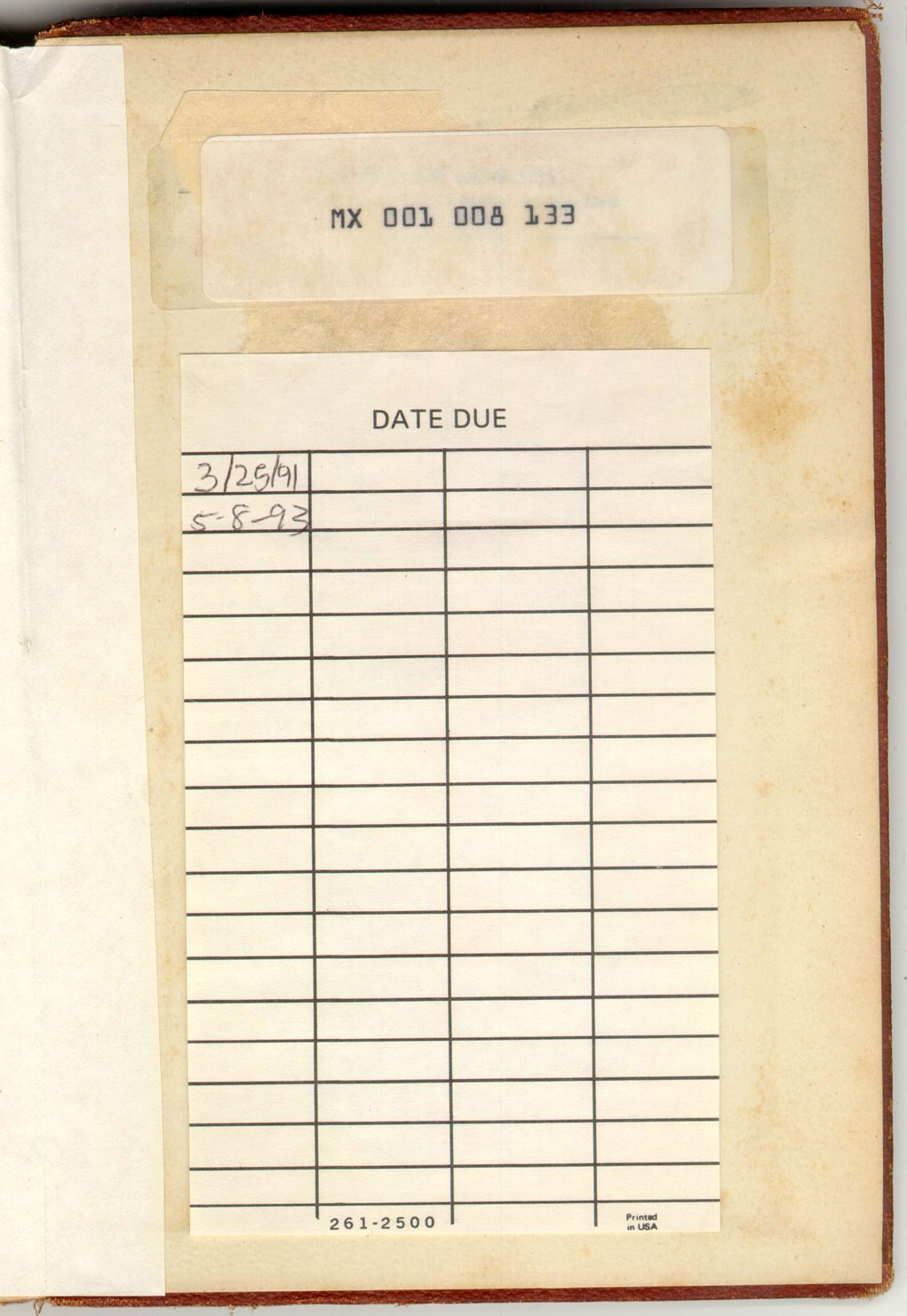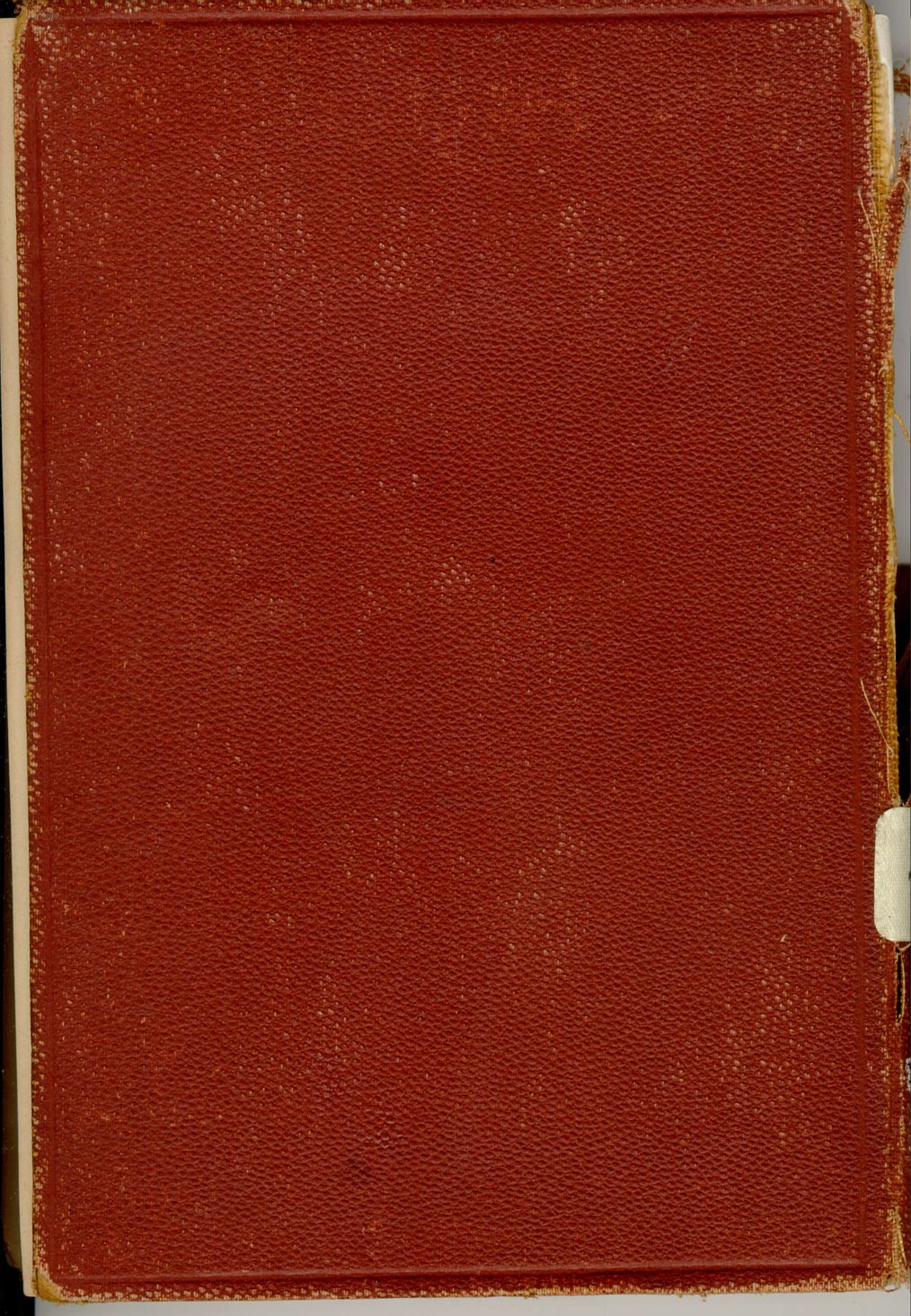|
CHAPTER X.
SUMMARY
The Common Frog | ||
10.
CHAPTER X.
SUMMARY
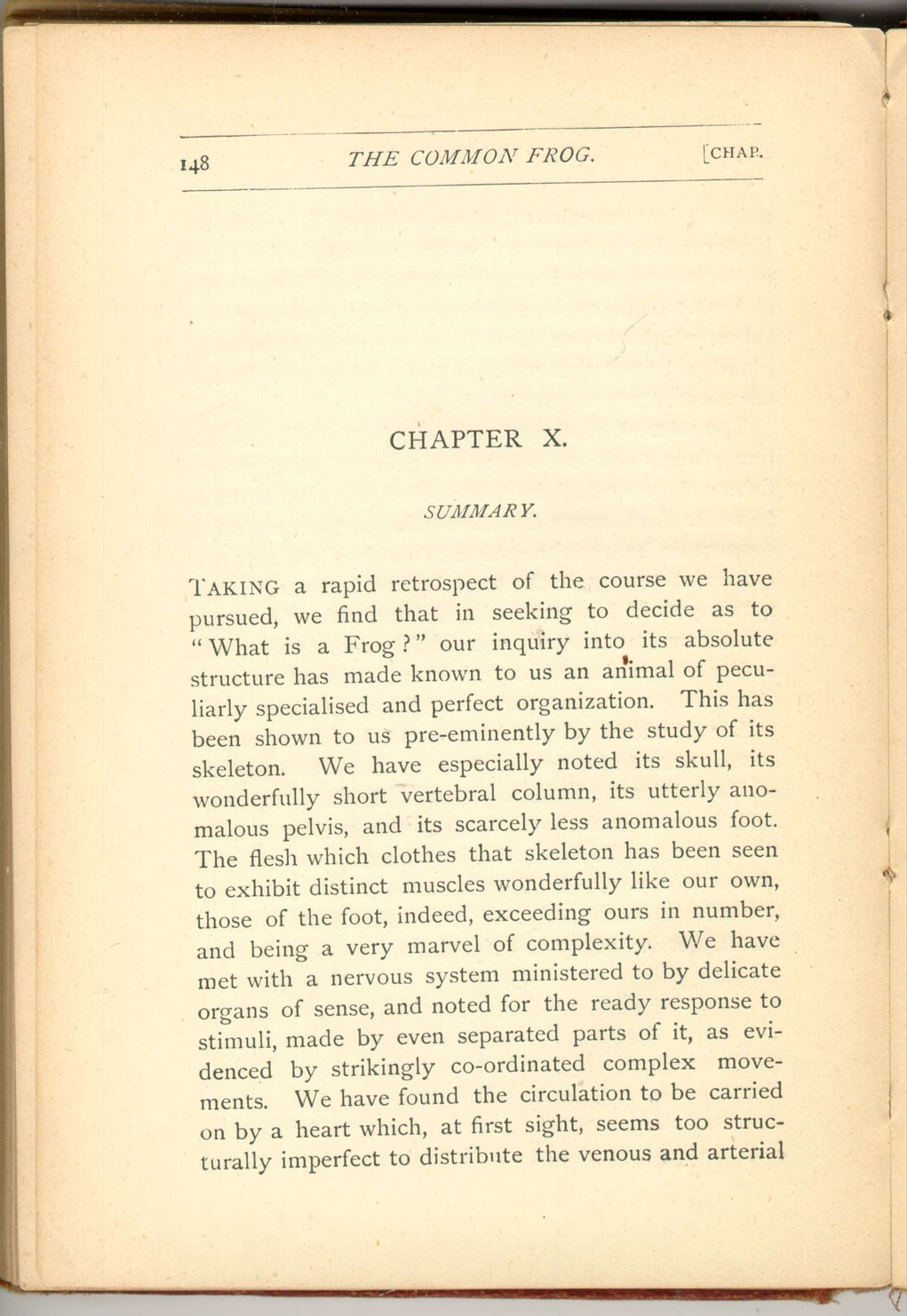 [Description:
Image of page 148.
]
[Description:
Image of page 148.
]
Taking a rapid retrospect of the
course we have pursued, we find that in seeking to decide as
to "What is a Frog?" our inquiry into its absolute structure
has made known to us an animal of peculiarly specialised and
perfect organization. This has been shown to us pre-eminently
by the study of its skeleton. We have especially noted its skull,
its wonderfully short vertebral column, its utterly anomalous
pelvis, and its scarcely less anomalous foot. The flesh which
clothes that skeleton has been seen to exhibit distinct muscles
wonderfully like our own, those of the foot, indeed, exceeding
ours in number, and being a very marvel of complexity. We have
met with a nervous system ministered to by delicate organs of
sense, and noted for the ready response to stimuli, made by even
separated parts of it, as evidenced by strikingly co-ordinated
complex movements. We have found the circulation to be carried
on by a heart which, at first sight, seems too structurally
imperfect to distribute the venous and arterial
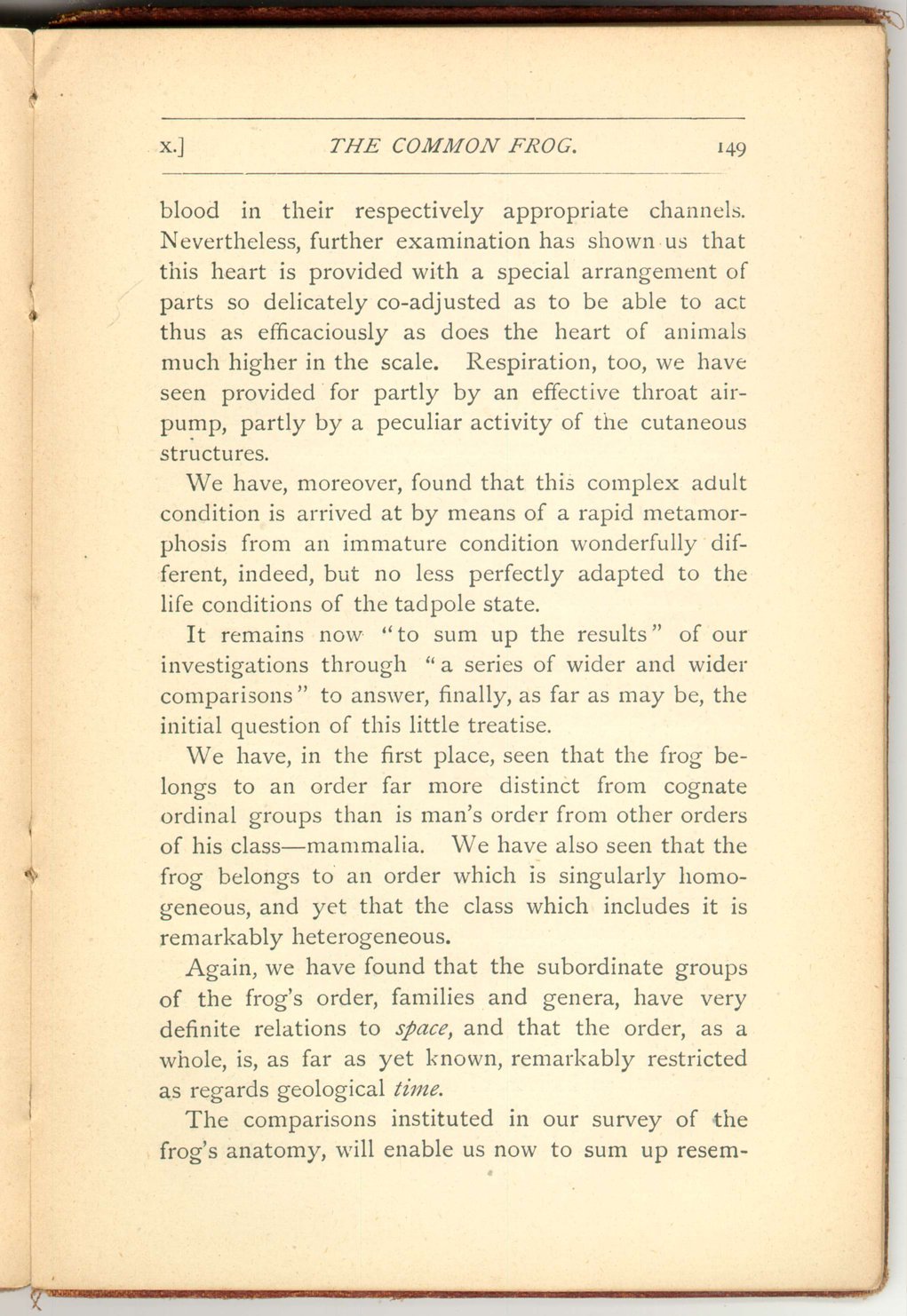 [Description:
Image of page 149.
]
[Description:
Image of page 149.
]
We have, moreover, found that this complex adult condition is arrived at by means of a rapid metamorphosis from an immature condition wonderfully different, indeed, but no less perfectly adapted to the life conditions of the tadpole state.
It remains now "to sum up the results" of our investigations through "a series of wider and wider comparisons" to answer, finally, as far as may be, the initial question of this little treatise.
We have, in the first place, seen that the frog belongs to an order far more distinct from cognate ordinal groups than is man's order from other orders of his class—mammalia. We have also seen that the frog belongs to an order which is singularly homogeneous, and yet that class which includes it is remarkably heterogeneous.
Again, we have found that the subordinate groups of the frog's order, family and genera, have very definite relations to space, and that the order, as a whole, is, as far as yet known, remarkably restricted as regards geological time.
The comparisons instituted in our survey of the frog's anatomy, will enable us now to sum up
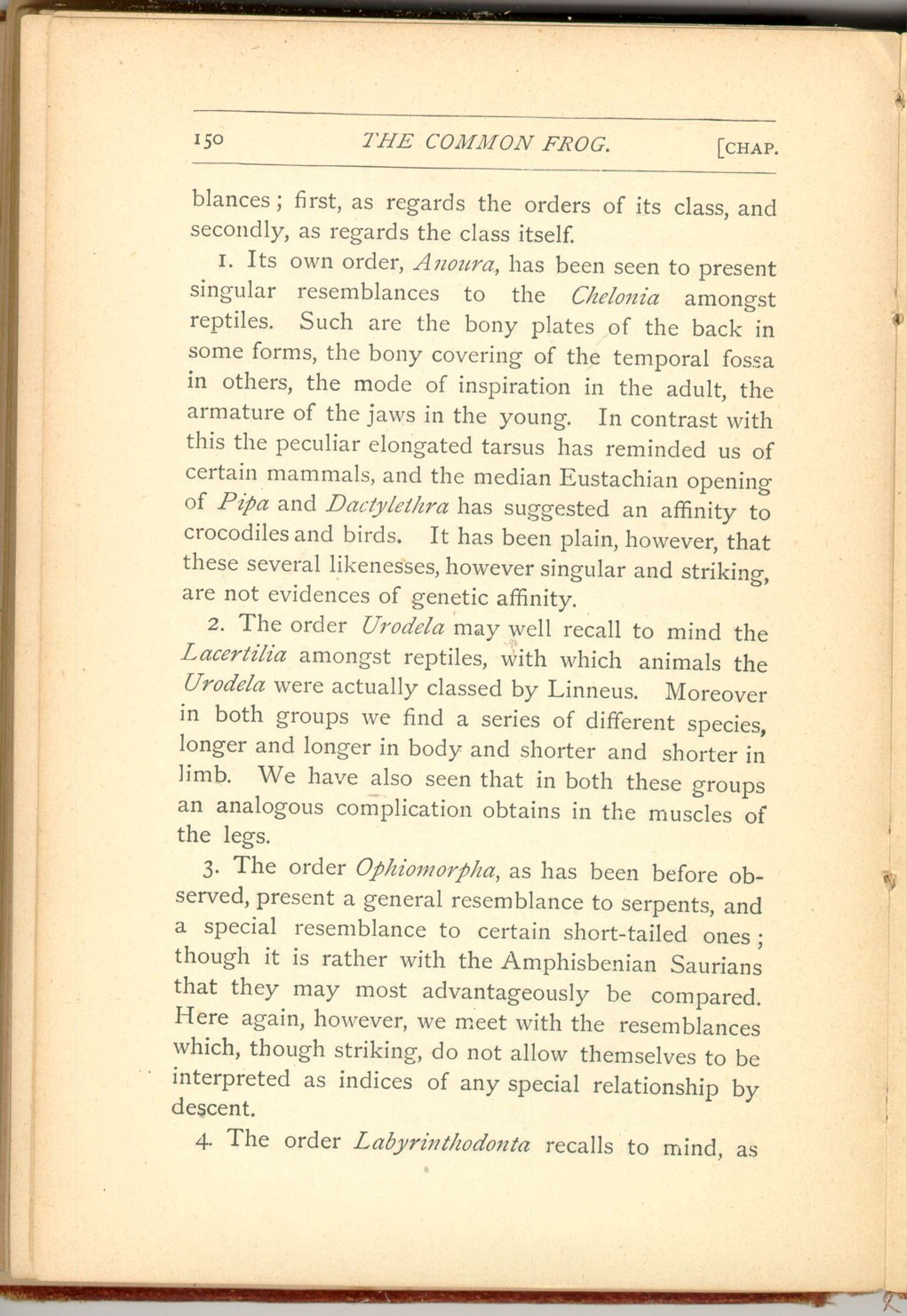 [Description:
Image of page 150.
]
[Description:
Image of page 150.
]
1. Its own order, Anoura, has been seen to present singular resemblances to the Chelonia amongst reptiles. Such are the bony plates of the back in some forms, the bony covering of the temporal fossa in others, the mode of inspiration in the adult, the armature of the jaws in the young. In contrast with this the peculiar elongated tarsus has reminded us of certain mammals, and the median Eustachian opening of Pipa and Dactylethra has suggested an affinity to crocodiles and birds. It has been plain, however, that these several likenesses, however singular and striking, are not evidences of genetic affinity.
2. The order Urodela may well recall to mind the Lacertilia amongst reptiles, with which animals the Urodela were actually classed by Linneus. Moreover in both groups we find a series of different species, longer and longer in body and shorter and shorter in limb. We have also seen that in both these groups an analogous complication obtains in the muscles of the legs.
3. The order Ophiomorpha, as has been before observed, present a general resemblance to serpents, and a special resemblance to certain short-tailed ones; though it is rather with the Amphisbenian Sauriansthat they may most advantageously be compared. Here again, however, we meet with the resemblances which, though striking, do not allow themselves to be interpreted as indices of any special relationship by descent.
4. The order Labyrinthodonta recalls to mind, as
151as has been said earlier, the Crocodilia amongst reptiles, of which they may be deemed as the prophetic precursors, so to speak, though certainly not the direct ancestors.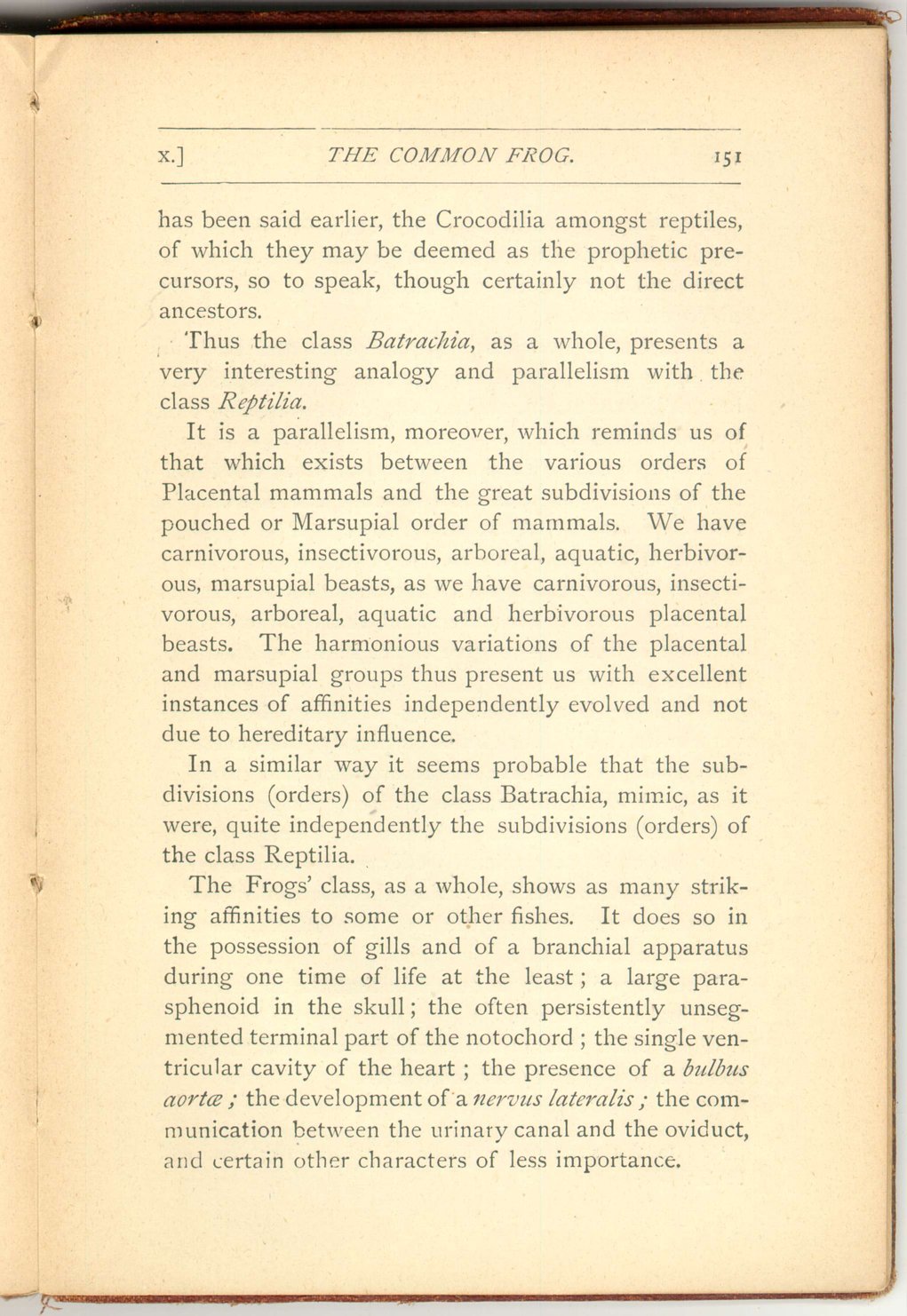 [Description:
Image of page 151.
]
[Description:
Image of page 151.
]
Thus the class Batrachia, as a whole, presents a very interesting analogy and parallelism with the class Reptilia.
It is a parallelism, moreover, which reminds us of that which exists between the various orders of Placental mammals and the great subdivisions of the pouched or Marsupial order of mammals. We have carnivorous, insectivorous, arboreal, aquatic, herbivorous, marsupial beasts, as we have carnivorous, insectivorous, arboreal, aquatic and herbivorous placental beasts. The harmonious variations of the placental and marsupial groups thus present us with excellent instances of affinities independently evolved and not due to hereditary influence.
In a similar way it seems probable that the subdivisions (orders) of the class Batrachia, mimic, as it were, quite independently the subdivisions (orders) of the class Reptilia.
The Frogs' class, as a whole, shows as many striking affinities to some or other fishes. It does so in the possession of gills and of a branchial apparatus during one time of life at the least; a large parasphenoid in the skull; the often persistently unsegmented terminal part of the notochord; the single ventricular cavity of the heart; the presence of a bulbus aortæ; the development of a nervus lateralis ; the communication between the urinary canal and the oviduct, and certain other characters of less importance.
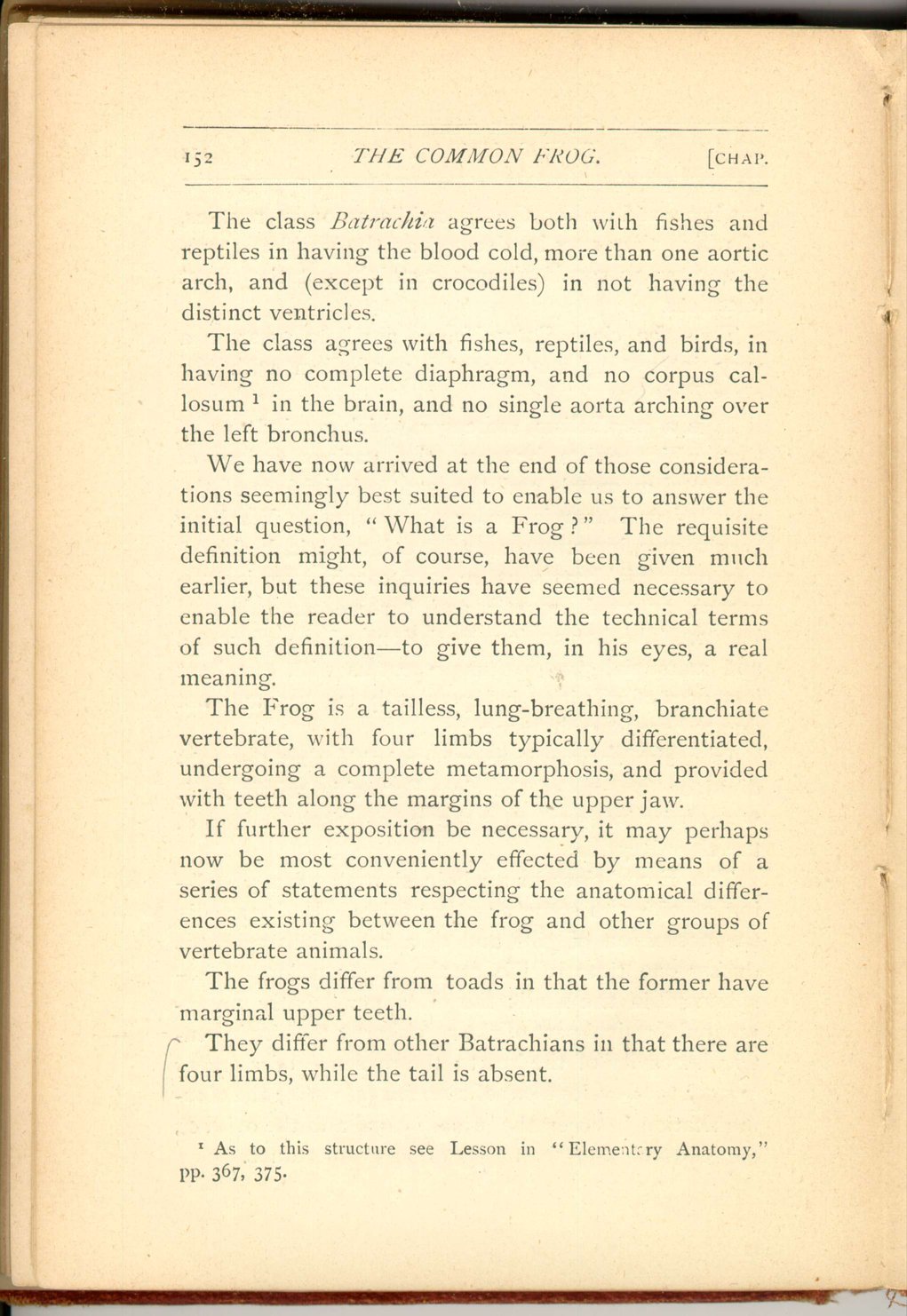 [Description:
Image of page 152.
]
[Description:
Image of page 152.
]
The class Batrachia agrees both with fishes and reptiles in having the blood cold, more than one aortic arch, and (except in crocodiles) in not having the distinct ventricles.
The class agrees with fishes, reptiles, and birds, in having no complete diaphragm, and no corpus callosum [24] in the brain, and no single aorta arching over the left bronchus.
We have now arrived at the end of those considerations seemingly best suited to enable us to answer the initial question, "What is a Frog?" The requisite definition might, of course, have been given much earlier, but these inquiries have seemed necessary to enable the reader to understand the technical terms of such definition—to give them, in his eyes, a real meaning.
The Frog is a tailless, lung-breathing, branchiate vertebrate, with four limbs typically differentiated, undergoing a complete metamorphosis, and provided with teeth along the margins of the upper jaw.
If further exposition be necessary, it may perhaps now be most conveniently effected by means of a series of statements respecting the anatomical differences existing between the frog and other groups of vertebrate animals.
The frogs differ from toads in that the former have marginal upper teeth.
They differ from other Batrachians in that there are four limbs, while the tail is absent.
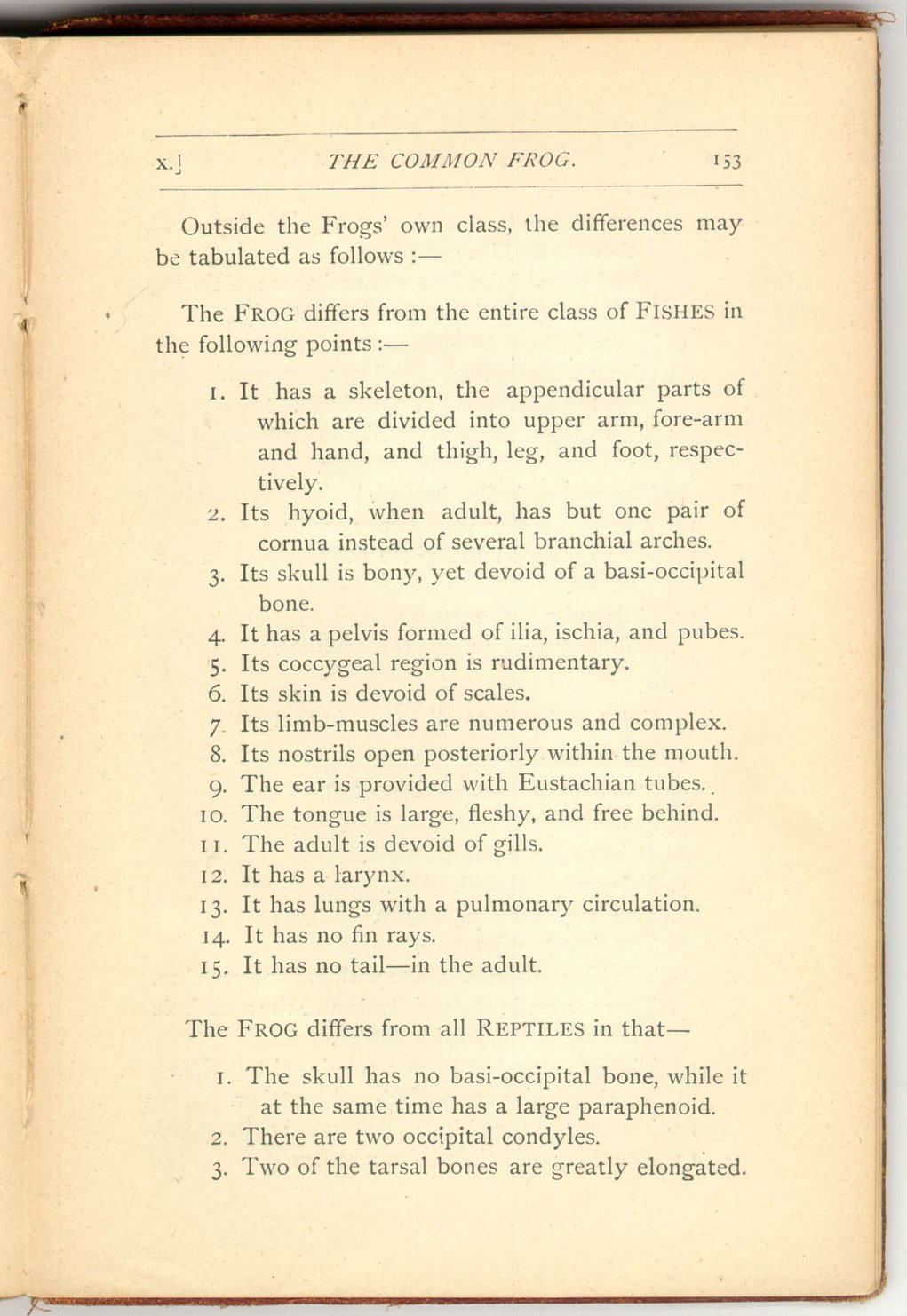 [Description:
Image of page 153.
]
[Description:
Image of page 153.
]
The Frog differs from the entire class of Fishes in the following points:—
- 1. It has a skeleton, the appendicular parts of which are divided into upper arm, fore-arm and hand, and thigh, leg, and foot respectively.
- 2. Its hyoid, when adult, has but one pair of cornua instead of several branchial arches.
- 3. Its skull is bony, yet devoid of a basi-occipital bone.
- 4. It has a pelvis formed of ilia, ischia, and pubes.
- 5. Its coccygeal region is rudimentary.
- 6. Its skin is devoid of scales.
- 7. Its limb-muscles are numerous and complex.
- 8. Its nostrils open posteriorly within the mouth.
- 9. The ear is provided with Eustachian tubes.
- 10. The tongue is large, fleshy, and free behind.
- 11. The adult is devoid of gills.
- 12. It has a larynx.
- 13. It has lungs with a pulmonary circulation.
- 14. It has no fin rays.
- 15. It has no tail—in the adult.
The Frog differs from all Reptiles in that—
- 1. The skull has no basi-occipital bone, while it at the same time has a large paraphenoid.
- 2. There are two occipital condyles.
- 3. Two of the tarsal bones are greatly elongated.
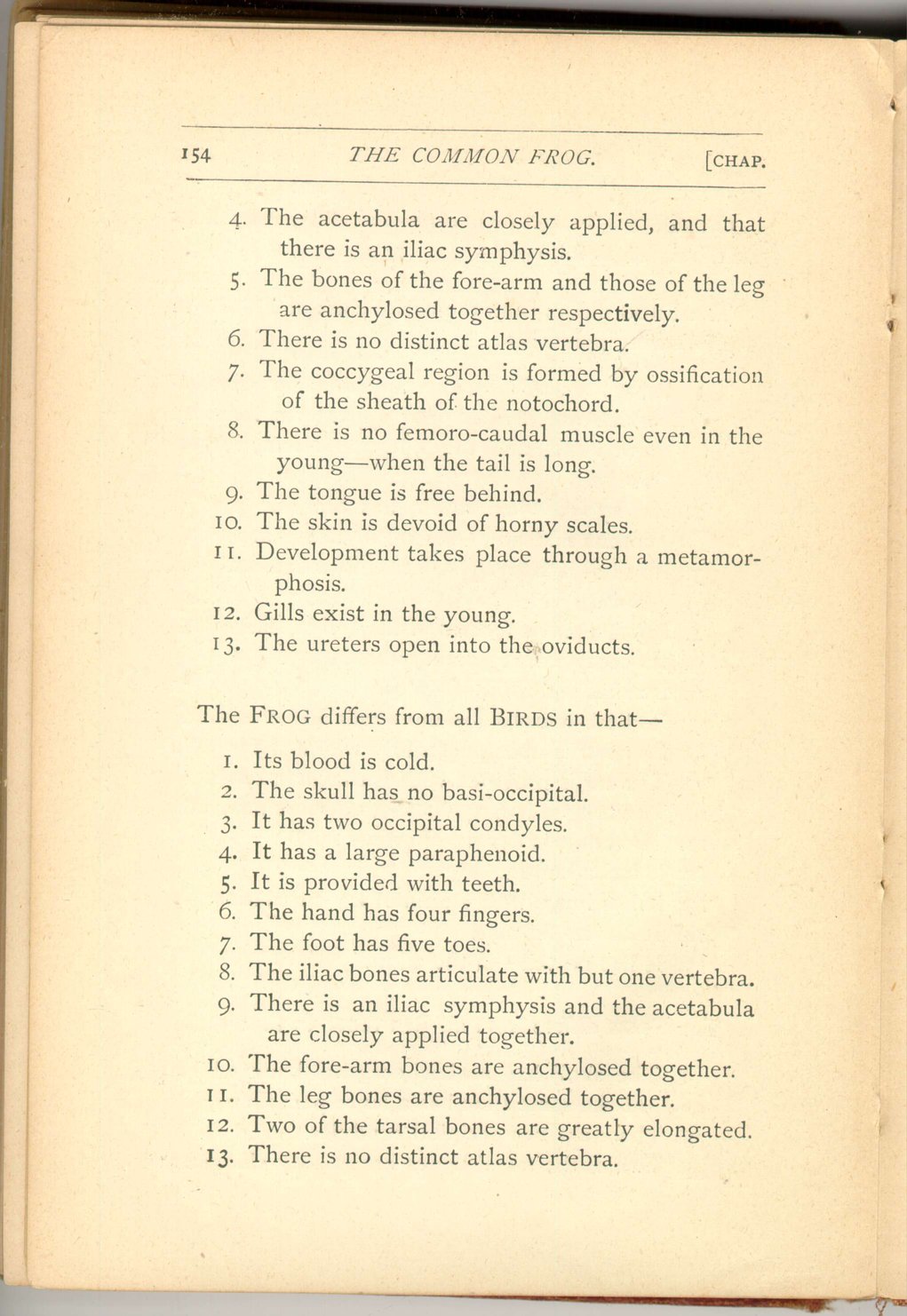 [Description:
Image of page 154.
]
[Description:
Image of page 154.
]
- 4. The acetabula are closely applied, and that there is an iliac symphysis.
- 5. The bones of the fore-arm and those of the leg are anchylosed together respectively.
- 6. There is no distinct atlas vertebra.
- 7. The coccygeal region is formed by ossification of the sheath of the notochord.
- 8. There is no femoro-caudal muscle even in the young—when the tail is long.
- 9. The tongue is free behind.
- 10. The skin is devoid of horny scales.
- 11. Development takes place through a metamorphosis.
- 12. Gills exist in the young.
- 13. The ureters open into the oviducts.
The Frog differs from all Birds in that—
- 1. Its blood is cold.
- 2. The skull has no basi-occipital.
- 3. It has two occipital condyles.
- 4. It has a large paraphenoid.
- 5. It is provided with teeth.
- 6. The hand has four fingers.
- 7. The foot has five toes.
- 8. The iliac bones articulate with but one vertebra.
- 9. There is an iliac symphysis and the acetabula are closely applied together.
- 10. The fore-arm bones are anchylosed together.
- 11. The leg bones are anchylosed together.
- 12. Two of the tarsal bones are greatly elongated.
- 13. There is no distinct atlas vertebra.
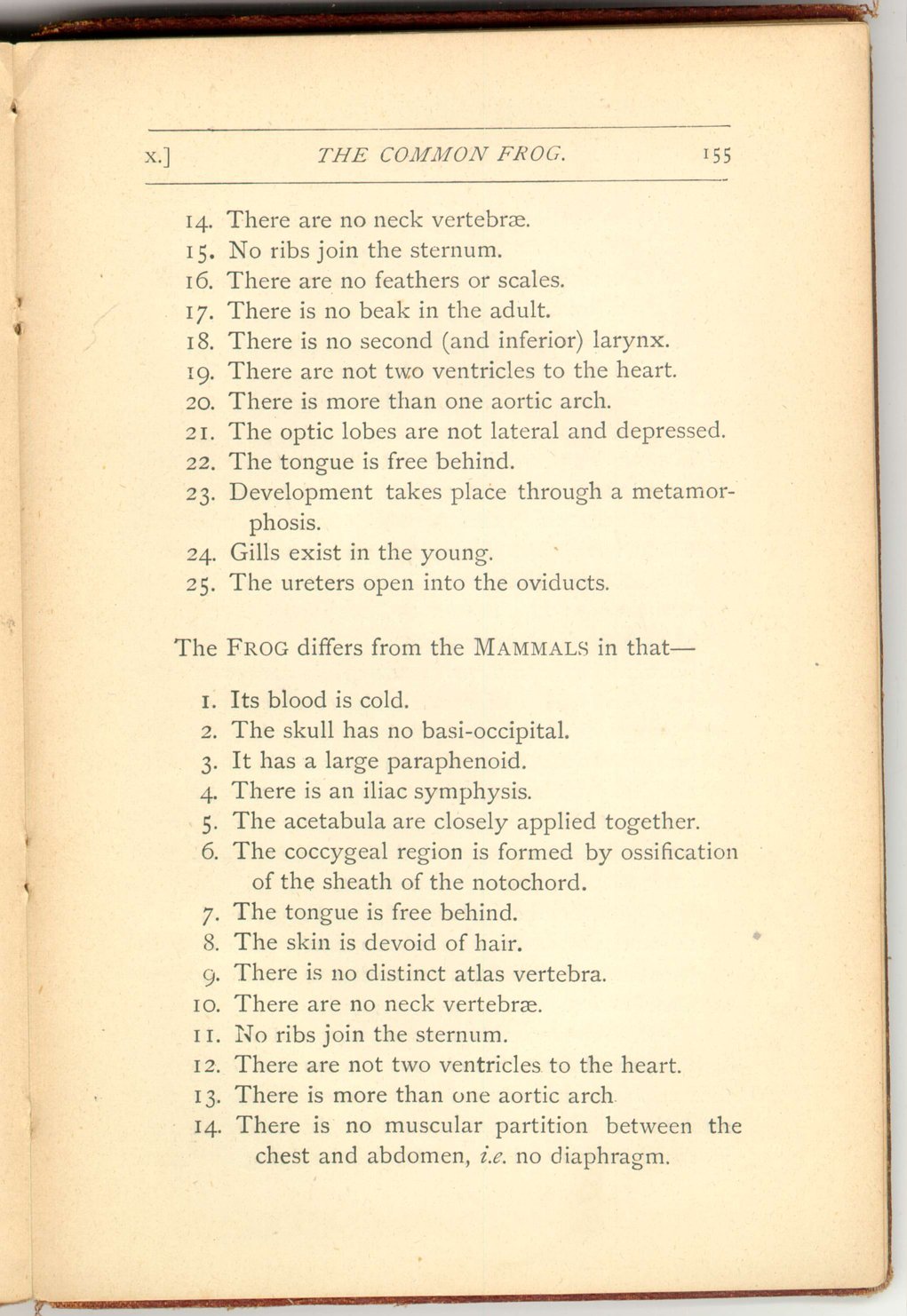 [Description:
Image of page 155.
]
[Description:
Image of page 155.
]
- 14. There are no neck vertebræ.
- 15. No ribs join the sternum.
- 16. There are no feathers or scales.
- 17. There is no beak in the adult.
- 18. There is no second (and inferior) larynx.
- 19. There are not two ventricles to the heart.
- 20. There is more than one aortic arch.
- 21. The optic lobes are not lateral and depressed.
- 22. The tongue is free behind.
- 23. Development takes place through a metamorphosis.
- 24. Gills exist in the young,
- 25. The ureters open into the oviducts.
The Frogdiffers from the Mammals in that—
- 1. Its blood is cold.
- 2. The skull has no basi-occipital.
- 3. It has a large paraphenoid.
- 4. There is an iliac symphysis.
- 5. The acetabula are closely applied together.
- 6. The coccygeal region is formed by ossification of the sheath of the notochord.
- 7. The tongue is free behind.
- 8. The skin is devoid of hair.
- 9. There is no distinct atlas vertebra.
- 10. There are no neck vertebræ.
- 11. No ribs join the sternum.
- 12. There are not two ventricles to the heart.
- 13. There is more than one aortic arch
- 14. There is no muscular partition between the chest and abdomen, i.e. no diaphragm.
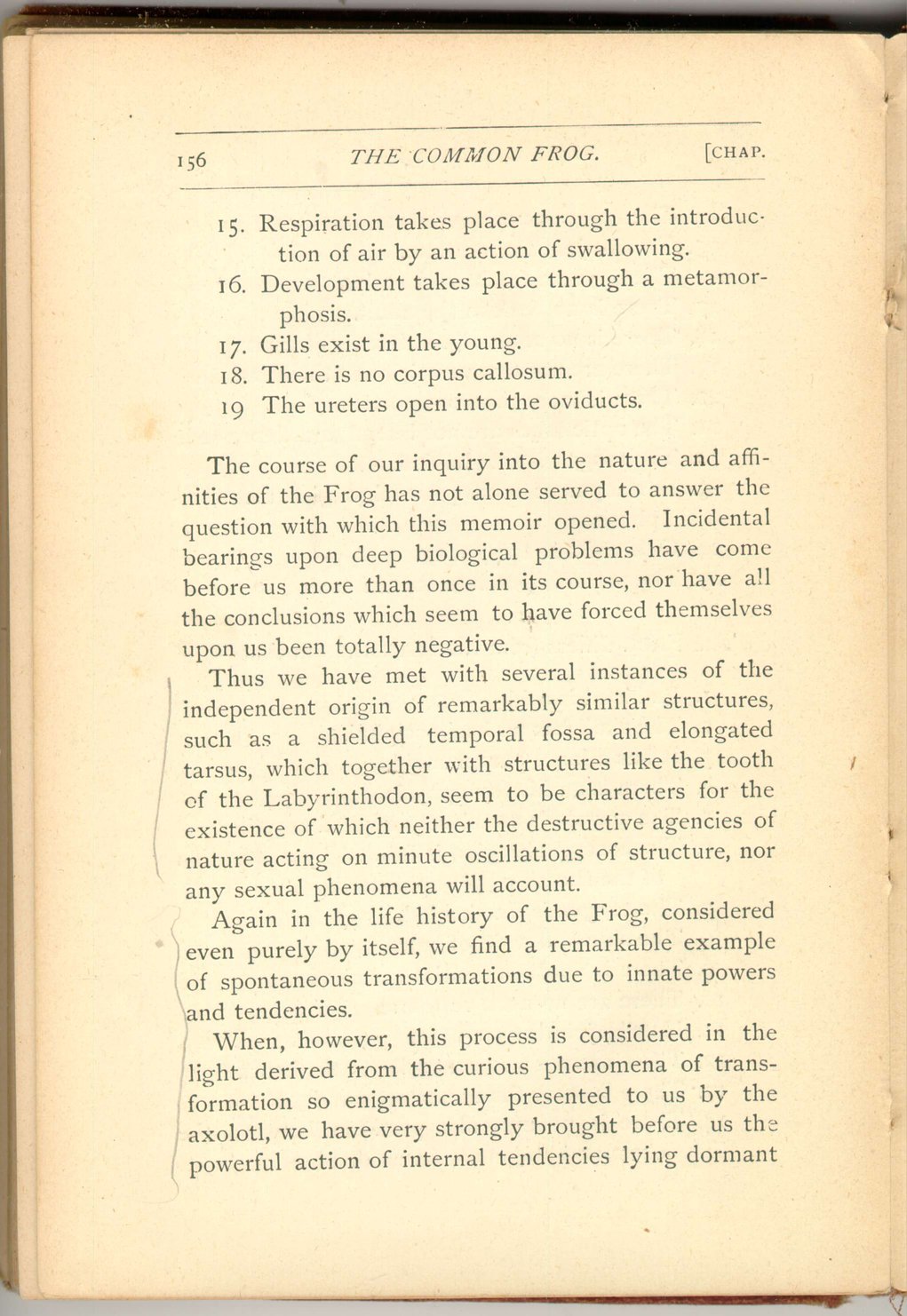 [Description:
Image of page 156.
]
[Description:
Image of page 156.
]
- 15. Respiration takes place through the introduction of air by an action of swallowing.
- 16. Development takes place through a metamorphosis.
- 17. Gills exist in the young.
- 18. There is no corpus callosum.
- 19. The ureters open into the oviducts.
The course of our inquiry into the nature and affinities of the Frog has not alone served to answer the question with which this memoir opened. Incidental bearings upon deep biological problems have come before us more than once in its course, nor have all the conclusions which seem to have forced themselves upon us been totally negative.
Thus we have met with several instances of the independent origin of remarkably similar structures, such as a shielded temporal fossa and elongated tarsus, which together with structures like the tooth of the Labyrinthodon, seem to be characters for the existence of which neither the destructive agencies of nature acting on minute oscillations of structure, nor any sexual phenomena will account.
Again in the life history of the Frog, considered even purely by itself, we find a remarkable example of spontaneous transformations due to innate powers and tendencies.
When, however, this process is considered in the light derived from the curious phenomena of transformation so enigmatically presented to us by the axolotl, we have very strongly brought before us the powerful action of internal tendencies lying dormant
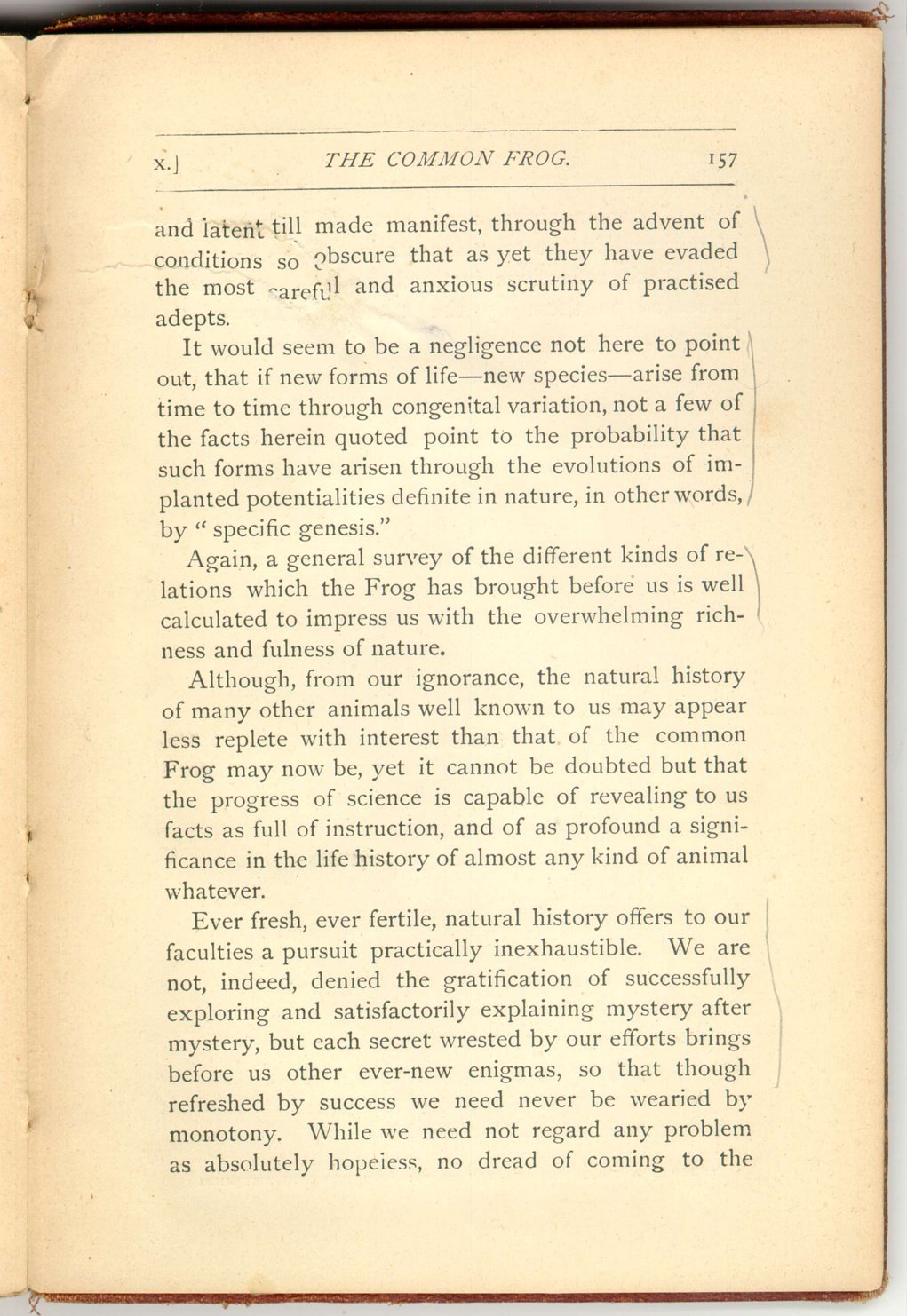 [Description:
Image of page 157.
]
[Description:
Image of page 157.
]
It would seem to be a negligence not here to point out, that if new forms of life—new species—arise from time to time through congenital variation, not a few of the facts herein quoted point to the probability that such forms have arisen through the evolutions of implanted potentialities definite in nature, in other words, by "specific genesis."
Again, a general survey of the different kinds of relations which the Frog has brought before us is well calculated to impress us with the overwhelming richness and fulness of nature.
Although, from our ignorance, the natural history of many other animals well known to us may appear less replete with interest than that of the common Frog may now be, yet it cannot be doubted but that the progress of science is capable of revealing to us facts as full of instruction, and of as profound a significance in the life history of almost any kind of animal whatever.
Ever fresh, ever fertile, natural history offers to our faculties a pursuit practically inexhaustible. We are not, indeed, denied the gratification of successfully exploring and satisfactorily explaining mystery after mystery, but each secret wrested by our efforts brings before us other ever-new enigmas, so that though refreshed by success we need never be wearied by monotony. While we need not regard any problem as absolutely hopeless, no dread of coming to the
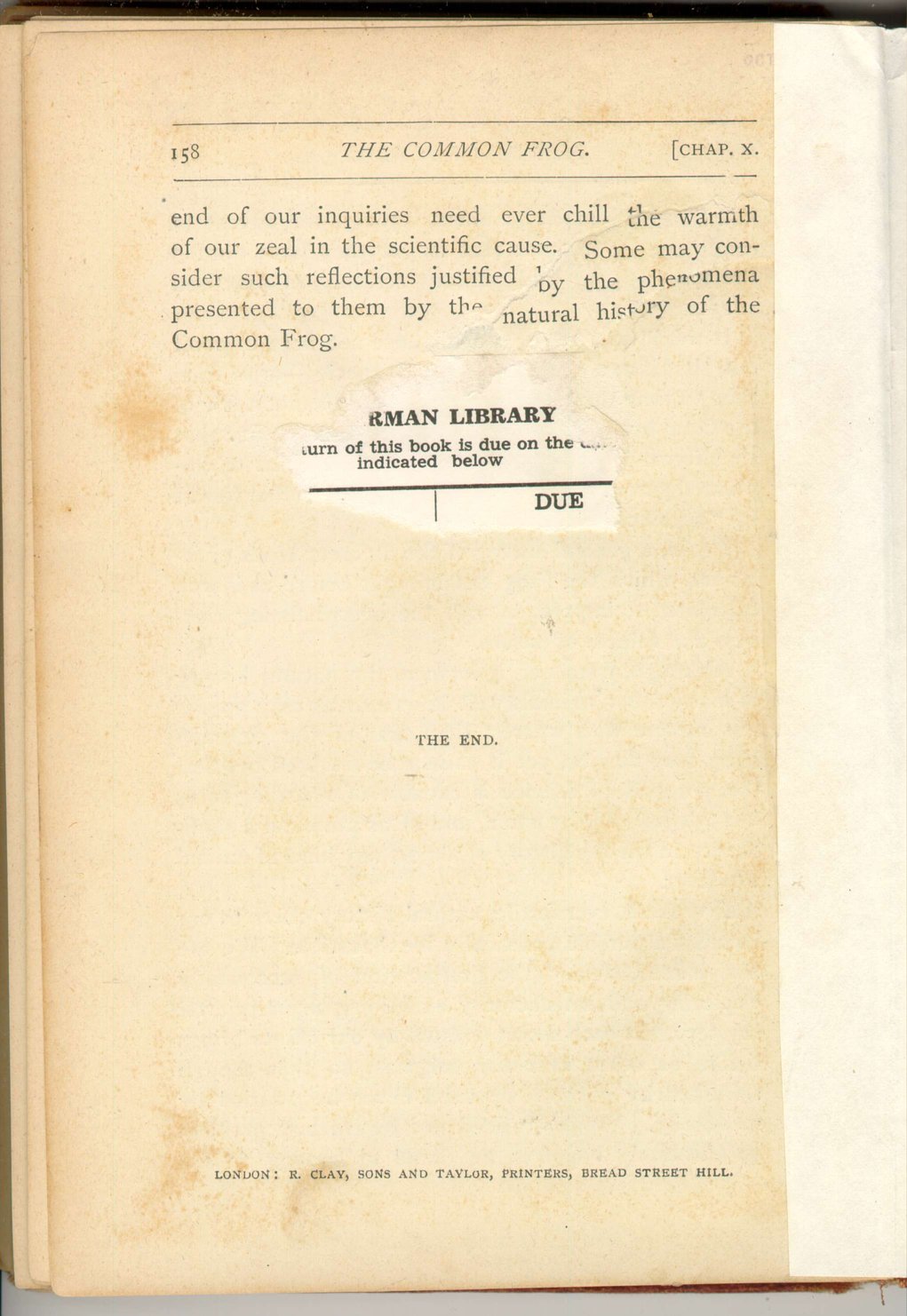 [Description:
Image of page 158.
]
[Description:
Image of page 158.
]
LONDON: R. CLAY, SONS AND TAYLOR, PRINTERS, BREAD STREET HILL.
FOOTNOTES: Chapter 10
|
CHAPTER X.
SUMMARY
The Common Frog | ||
